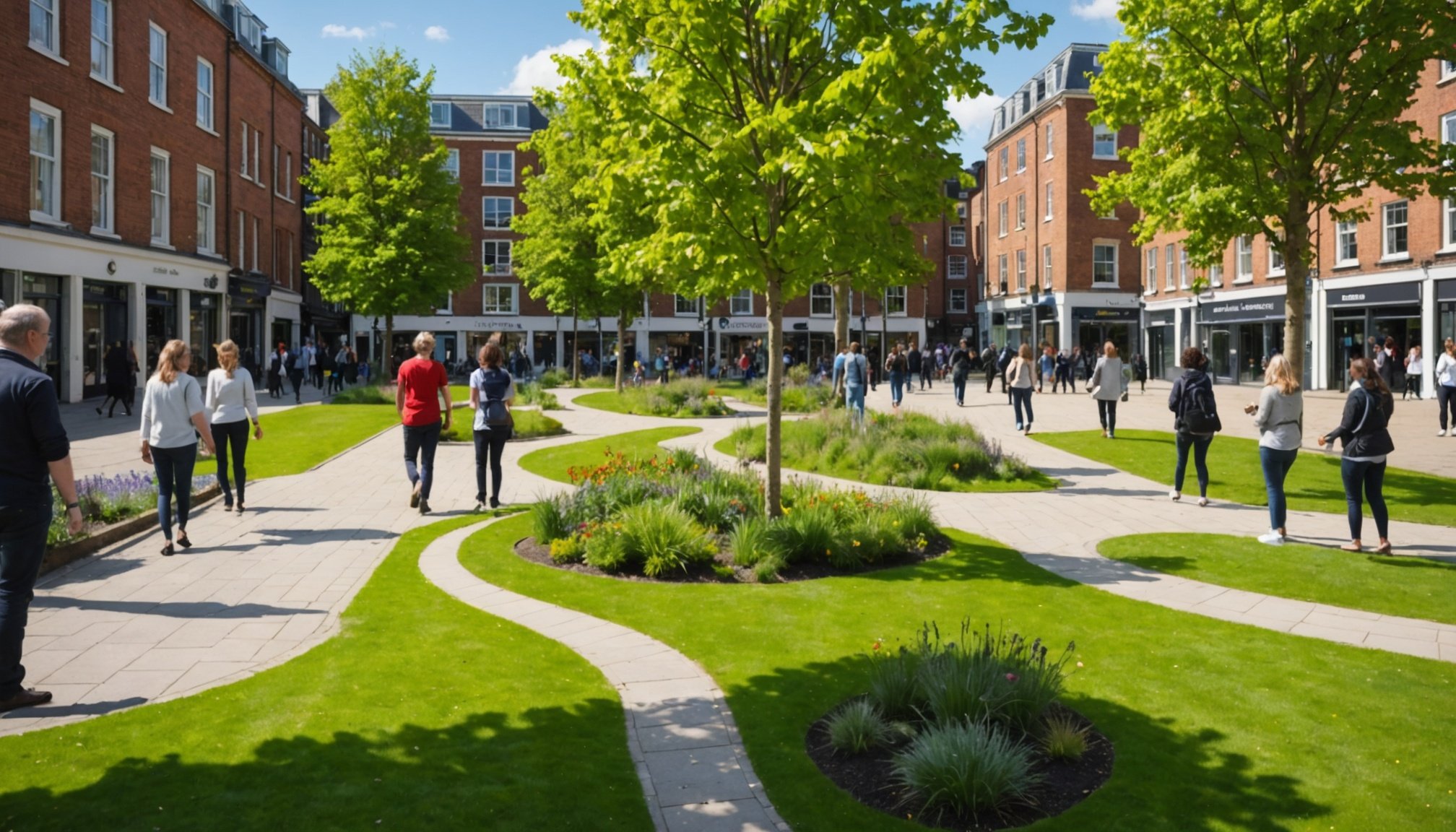Understanding Smart Parks
In today’s cities, Smart Parks are revolutionizing urban spaces by integrating technology with natural environments. Essentially, a Smart Park is an urban green space enhanced with modern tech features such as Wi-Fi, interactive kiosks, and energy-efficient lighting. These parks are designed not merely as places of leisure but as hubs for innovation in Urban Development.
The significance of urban green spaces stretches beyond aesthetics to profoundly impact Community Well-Being. Such parks offer residents a retreat from urban stress, providing mental and physical health benefits through fresh air and recreational activities. They also contribute to biodiversity, improving the overall ecosystem health within cities.
Have you seen this : Essential Strategies for UK Residents to Safeguard Against Water Shortages
One standout feature of Smart Parks is their capacity for technological integration. These spaces often feature solar panels powering amenities, sensors monitoring environmental conditions, and apps that guide visitors through park attractions. This seamless blend of nature and technology underpins sustainable city growth and enhances community interaction.
Furthermore, Smart Parks can be customized to meet different community needs, contributing to a more inclusive urban environment. Whether it’s adaptive playgrounds, connected walking paths, or community gardens, the possibilities in Urban Development are vast and directly enhance Community Well-Being.
Also to read : Crafting an Engaging Financial Literacy Curriculum for Teenagers in the UK: A Step-by-Step Guide
Design Principles for Community-Centric Smart Parks
In shaping smart parks that genuinely cater to the needs of their communities, several design elements are pivotal. These parks create environments where people can connect, play, and relax, all while integrating advanced technologies seamlessly into the natural landscape.
Essential Elements of Smart Park Design
A successful design should focus on user-centric spaces that encourage social interactions. Spaces like open plazas, interactive equipment areas, and multi-use paths are essential for community engagement. These elements not only enhance urban aesthetics but also foster a sense of belonging among visitors.
Incorporating Nature and Green Infrastructure
The integration of natural features, such as trees and native plants, is crucial. These efforts improve biodiversity, reduce urban heat spots, and enhance air quality. Additionally, green infrastructure solutions, like rain gardens and permeable paths, manage stormwater while adding to the beauty of the park environment.
Creating Inclusive Spaces for All
Ensuring accessibility is vital. Parks should include features like wide pathways, signage in multiple formats, and inclusive playground equipment. These strategies remove barriers, offering everyone the chance to enjoy the park regardless of age or ability. Such inclusive spaces make it possible for communities to gather, celebrate, and thrive together.
Case Studies of Successful Smart Parks in the UK
Smart parks in the UK have become prime examples of innovative urban planning success, where technology and nature harmoniously intertwine. One remarkable example can be found in Manchester’s Smart Garden, a pioneering project that uses sensors and IoT technology to monitor environmental conditions. This park is a testament to how technology can enhance nature without overpowering it. Another noteworthy case is the Future Park Project in Birmingham, which has revitalised urban spaces by integrating solar energy and interactive installations to foster active community engagement.
Examining the community impact of these projects, it is clear that community engagement is a pivotal component. In both Manchester and Birmingham, residents were actively involved in the design phase, leading to spaces that reflect the needs and desires of local inhabitants. This participatory approach has fostered a sense of ownership and pride among residents, which in turn ensures the park’s upkeep.
From these initiatives, crucial best practices have emerged, such as prioritising user-friendly technology, ensuring that technological elements serve a clear purpose, fostering partnerships with local organisations, and maintaining transparent communications with the community. These practices are essential for replicating such success in future urban planning projects.
Engaging the Community in Smart Park Development
In today’s world, community engagement has become an integral part of any development project, including smart parks. Harnessing the power of public participation ensures that the projects are aligned with the needs and aspirations of the people they serve. This results in parks that foster a sense of ownership and pride within the community.
Strategies for Effective Community Involvement
Ensuring effective community engagement begins with recognising the diverse voices within a community. Utilizing surveys and local meetings helps gather a wide range of opinions, ensuring all voices are heard. Incentivising participation with small rewards can further boost involvement.
Collaborating with Local Organizations
Teaming up with local groups and organizations is valuable for gathering insights and public participation. These collaborations leverage local knowledge, provide valuable feedback, and often facilitate smoother decision-making processes. Consider forming partnerships with schools, non-profits, and local businesses.
Organizing Workshops and Feedback Sessions
Interactive sessions are key to stakeholder collaboration. Workshops encourage dialogue and idea-sharing. To be effective, these sessions should be structured, with clear goals and outcomes. Feedback sessions allow community members to express opinions in an open environment, ensuring the final park development truly reflects their desires and needs.
Sustainability Practices for Smart Parks
In the realm of sustainable urban development, modern parks serve as pivotal spaces that align eco-friendly design with human enjoyment. To create environmentally responsible parks, planners incorporate sustainable materials and advanced technologies, ensuring longevity and reduced ecological footprints. Materials such as recycled composites and sustainably sourced wood are frequently utilized. These choices not only decrease waste but also promote the use of renewable resources.
Meanwhile, eco-friendly design extends to water management and energy efficiency. Smart irrigation systems, for example, control water usage precisely, reducing waste. Additionally, the use of solar panels and wind turbines can transform a park into a mini energy hub, powering lights and amenities sustainably. Such green practices might include native plant landscaping, which requires less water and supports the local ecology.
Urban parks also play a crucial role in encouraging biodiversity and supporting wildlife. These spaces often include carefully designed habitats that accommodate a range of species. Features like bird boxes and insect hotels create sanctuaries within the city, promoting ecological balance. By integrating these sustainable practices, smart parks not only enhance urban settings but also serve as model examples of green practices that prioritize both environment and community engagement.
Technological Integrations in Smart Parks
With the rise of smart technology, urban parks have embraced urban innovation to enhance both management and user experience. These green spaces are transforming into data-driven hubs, offering practical and engaging solutions for cities and their inhabitants.
Utilizing IoT for Park Management
The Internet of Things (IoT) is revolutionizing how parks are monitored, enabling efficient management through connected devices. Sensor networks can track environmental conditions like humidity, soil moisture, and air quality. This data-driven approach helps park managers make informed decisions, optimising resource allocation and maintenance efforts. By leveraging real-time data, urban parks can sustain their ecological health while enhancing safety and visitor experience.
Enhancing Visitor Experience through Technology
Smart technology plays a pivotal role in elevating the visitor journey. Key innovations include mobile apps offering interactive maps, guided tours, and activity alerts. These tools personalize visitor experience, fostering engagement and encouraging exploration. Smart lighting and Wi-Fi access points further improve ambience and connectivity, making time spent in these parks more inviting and convenient.
Case Examples of Tech Implementation
Cities across the globe exemplify successful application of smart technology in urban parks. Seoul’s IoT-equipped parks use sensors to collect environmental data for effective management, while Barcelona’s Parc Central del Poblenou integrates digital information panels to engage visitors. These implementations highlight how urban innovation can create greener, smarter cities.
Benefits of Smart Parks for Mental Health and Social Cohesion
The integration of smart parks with green spaces offers significant benefits for both mental health and social well-being. Numerous studies have illustrated the mental health advantages of spending time in nature, highlighting improvements in mood, reduced stress, and enhanced cognitive function. Green spaces act as a natural balm, providing a tranquil escape from urban environments, allowing individuals to unwind and rejuvenate.
Beyond individual health benefits, smart parks play a pivotal role in fostering community cohesion. They serve as vital hubs for social interaction, encouraging residents to engage with one another. Through activities such as group exercises, community gardening, or simply gathering in shared areas, parks enhance social well-being by building and strengthening relationships among community members.
Community resilience is also bolstered through these shared spaces. By providing a common ground where individuals can come together, collaborate, and support one another, smart parks help build a united front against societal challenges. They become places where people can bond over shared interests, leading to a more cohesive community.
In this way, smart parks serve not only as centers for relaxation and recreation but also as facilitators of societal unity and a sense of belonging.
Practical Steps for Implementing Smart Parks
When considering smart park development, it’s crucial to identify the most effective implementation strategies. A thorough understanding of community needs and available resources is the first step in the process.
Assessing Community Needs and Resources
Engaging with the local community enables a detailed evaluation of their recreational desires and necessities. Surveys, public consultations, and workshops can provide valuable insights. These methods gather direct feedback, ensuring that the park development aligns with community interests and expectations. It is essential to invest time in this project planning phase to build a park that resonates with its users.
Identifying Funding Opportunities
Securing funding for park development is often a make-or-break factor. Numerous funding sources exist, including government grants, private donations, and partnerships with local businesses. Exploring these funding opportunities early can help create a robust financial foundation. Consider applying for government programs or green initiatives, which often support environmentally-friendly projects.
Establishing a Project Timeline
Establishing a clear project timeline is indispensable for efficient implementation. It allows for structured progression through planning, design, and construction phases. A detailed timeline minimizes disruptions and helps synchronize activities with the availability of resources and funding. By setting realistic deadlines for each milestone, park development teams ensure cohesive and efficient workflow. This aspect of project planning is critical to achieving the desired outcomes within a set period.
Challenges in Developing Smart Parks
Initiating urban park projects frequently encounters significant Urban Challenges. Complexities arise from constraints like limited space, regulatory hurdles, and resource allocation. Barriers to Development often stem from balancing ecological preservation with urbanization needs. Additionally, intricate zoning and planning regulations further complicate progress.
Project Obstacles in urban park development can be mitigated by adopting strategic approaches. One on hand, integrating advanced technology solutions enables more efficient planning and resource management. On the other hand, leveraging innovative public-private partnerships can alleviate financial and logistical constraints. This symbiotic collaboration fosters a streamlined development process while enhancing potential environmental and social benefits.
Addressing Barriers to Development requires engaging diverse stakeholders early in the process. Active community involvement and feedback can guide decision-making, aligning project goals with public interest. Regular stakeholder consultations ensure transparency, building trust and reducing opposition. Ultimately, a collaborative approach mitigates Project Obstacles by creating more resilient urban park initiatives.
Navigating Urban Challenges presents an opportunity for creative problem-solving and transformative planning. Focusing on sustainable and inclusive design ensures smarter parks. Greater emphasis on adaptive strategies not only anticipates future developments but also enhances the park’s value to the broader urban context.











